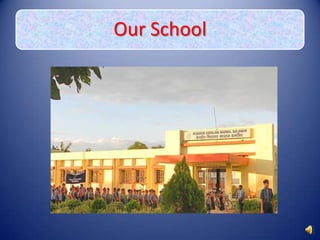
History of computer by Siddhartha Kumar Panda
- 1. Our School
- 3. Presents……
- 5. The earliest known tool for use in computation was the Abacus, developed in period 2700–2300 BC in Sumer. The Abacus is a calculating tool used primarily in parts of Asia for performing arithmatic processes. The abacus was in use centuries before the adoption of the written modern numeral system.
- 8. COMPUTER The word 'computer' comes from the word compute which means 'to calculate'. The history of computer development is often referred to in reference to the different generations of computing devices. With each new generation, speed, power, and computer memory has proportionately increased.
- 11. LEIBNIZ WHEEL First Gottfried Leibniz invented his Leibniz wheels after 1671 while trying to add an automatic multiplication feature to the Pascaline. A Leibniz wheel was a cylinder with a set of teeth of incremental lengths which, when coupled to a counting wheel, was used in the calculating engine of a class of mechanical calculators.
- 13. The Arithmometer , invented by Thomas de Colmar in 1820 ,was the first mechanical calculator . This calculator could add and subtract two numbers directly and could perform long multiplications and divisions effectively by using a movable accumulator for the result.
- 14. DIFFERENCE ENGINE In 1822, Charles Babbage invented Difference Engine. A difference engine is an automatic mechanical calculator designed to tabulate polynomial functions. Both logarithmic and trigonometric functions can be approximated by polynomials.
- 15. In 1837, Charles Babbage was the first to conceptualize and design a fully programmable mechanical computer. The Analytical Engine incorporated an arithmetic logic unit, control flow in the form of conditional branching and loops, and integrated memory, making it the first design for a general-purpose computer. Babbage was never able to complete construction of any of these machines due to conflicts with his chief engineer and inadequate funding.
- 16. ANALYTICAL ENGINE But , Charles Babbage’s son, Henry Babbage, completed a simplified version of the analytical engine's computing unit (the mill) in 1888. He gave a successful demonstration of its use in computing tables in 1906. The input was provided to the machine via punched cards and for output, the machine had a curve plotter and a bell.
- 17. And Research Going On…
- 18. By the end of the 19th century a number of ideas and technologies had begun to appear: Boolean algebra, the vacuum tube (thermionic valve), punched cards and tape, and the teleprinter . During the first half of the 20th century, many scientific computing needs were met by analog computers. But, these were not programmable and generally lacked the versatility and accuracy of modern digital computers. Ada Lovelace designed first computer algorithm, which had the ability to compute Bernoulli’s numbers. His machine not only performed mathematical calculations, but also manipulated symbols, mathematical or not. In 1936, Alan Turing introduced the formalization of an algorithm, with limits on what can be computed. His thesis claims that any calculation that is possible can be performed by an algorithm running on a computer . In 1937, George Stibitz (recognized as father of the modern digital computer) invented and built a relay-based calculator “Model K” which was the first to use binary circuits to perform an arithmetic operation.
- 19. The Atanasoff–Berry Computer (ABC) was the world's first electronic digital computer, not programmable.
- 20. In 1946, a model for computer architecture was introduced and became known as von Neumann Architecture The von Neumann Architecture introduced an idea of allowing machine instructions and data to share memory space. The von Neumann model is composed of 3 major parts, the arithmetic logic unit (ALU), the memory, and the instruction processing unit (IPU).
- 21. Generations of Computer A generation of computer refers to the state of improvement in the product development process. This term is also used in the different advancements of new computer technology. With each new generation, the circuitry has gotten smaller and more advanced than the previous generation before it. As a result of this, speed, power, and computer memory has proportionately increased. Each generation of computers is characterized by major technological development that fundamentally changed the way computers operate.
- 27. Computer… We are using now…
- 28. Peripherals…. The phrase computing machine gave away, after the late 1940s, to just Computer. It receives data from various sources and combines it with instructions to produce the desired results. A computer consists of 3 parts Input Device Central Processing Unit Arithmatic & Logic Unit Control Unit Output Device
- 29. Input Device In computing, an input device is any peripheral (piece of computer hardware equipment) used to provide data and control signals to a computer . . . .
- 30. Central Processing Unit… A central processing unit (CPU) is the hardware within a computer that carries out the instructions of a computer program by performing the basic arithmetical, logical, and input/output operations of the system. Two typical components of a CPU are the arithmetic logic unit (ALU), which performs arithmetic and logical operations, and the control unit (CU), which extracts instructions from memory and decodes and executes them, calling on the ALU when necessary. A computer can have more than one CPU; this is called multiprocessing.
- 31. CPU
- 32. Output Devices… An output device is any piece of computer hardware equipment used to communicate the results of data processing carried out by a computer which converts the electronically generated information into human-readable form. . ..
- 33. Pictorial Representation of Input Devices, Output Devices & Common Uses…
- 34. Computers A ChronologicalTimeline (A History of Computers)
- 35. A Simple Question from… Sixth Generation Kids….
- 36. Thanks ... For giving Your Valuable Time…
